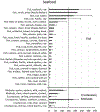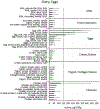Iodine in Foods and Dietary Supplements: A Collaborative Database Developed by NIH, FDA and USDA
- PMID: 35967902
- PMCID: PMC9365050
- DOI: 10.1016/j.jfca.2021.104369
Iodine in Foods and Dietary Supplements: A Collaborative Database Developed by NIH, FDA and USDA
Abstract
Data on the iodine content of foods and dietary supplements are needed to develop general population intake estimates and identify major contributors to intake. Samples of seafood, dairy products, eggs, baked products, salts, tap water, other foods and beverages, and dietary supplements were collected according to established sampling plans of the U.S. Department of Agriculture (USDA) and the U.S. Food and Drug Administration (FDA). Samples were assayed for iodine content using inductively coupled plasma mass spectrometry with rigorous quality control measures. The food data were released through a collaboration of USDA, FDA, and the Office of Dietary Supplements-National Institutes of Health (ODS-NIH) as the USDA, FDA, and ODS-NIH Database for the Iodine Content of Common Foods at www.ars.usda.gov/mafcl. Iodine data for dietary supplements are available in the ODS-USDA Dietary Supplement Ingredient Database and the ODS Dietary Supplement Label Database. Data from the iodine databases linked to national dietary survey data can provide needed information to monitor iodine status and develop dietary guidance for the general U.S. population and vulnerable subgroups. This iodine information is critical for dietary guidance development, especially for those at risk for iodine deficiency (i.e., women of reproductive age and young children).
Keywords: analysis; database; dietary supplements; foods; iodine; nutrient data.
Conflict of interest statement
Conflicts of interest The authors, shown above, have no conflicts of interest.
Figures














References
-
- Andrews KW, Gusev PA, McNeal M, Savarala S, Dang PTV, Oh L, Atkinson R, Pehrsson PR, Dwyer JT, Saldanha LG, Betz JM, Costello RB, Douglass LW (2018). Dietary Supplement Ingredient Database (DSID) and the application of analytically based estimates of ingredient amount to intake calculations. Journal of Nutrition, 148 (Suppl_2), 1413S–1421S. - PMC - PubMed
-
- Andrews KW, Roseland JM, Gusev PA, Palachuvattil J, Dang PT, Savarala S, Han F, Pehrsson PR, Douglass LW, Dwyer JT, Betz JM, Saldanha LG, Bailey RL (2017). Analytical ingredient content and variability of adult multivitamin/mineral products: national estimates for the Dietary Supplement Ingredient Database. American Journal of Clinical Nutrition, 105(2), 526–539. - PMC - PubMed
-
- Andrews KW, Palachuvattil J, Dang PT, Gusev P, Savarala S, Pehrsson PR Iodine content of OTC prenatal MVM supplements. Assessment of Iodine Intake: Food and Supplements Roundtable. April 22–23, 2014.
-
- Bianchi LM, Phillips KM, McGinty RC, Ahuja JK, Pehrsson PR (2019). Cooking parameters affect the sodium content of prepared pasta. Food Chemistry, 271, 479–487. - PubMed
Grants and funding
LinkOut - more resources
Full Text Sources
Miscellaneous
